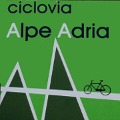


A route that is part of the Ciclovia Alpe Adria [Alps to Adriatic bike route] which follows the Canale del Ferro [the iron channel], which is nothing more than the valley of the Fella River, which upon reaching Carnia, flows into the Tagliamento [river]. Carnia is a community that is part of the town of Venzone, where this bike route ends.
The point of departure is the train station at Pontebba. Take the street behind the station, or the one in front if you will, and head towards Carnia. Follow the main street of Pontebba and shortly after you leave the village, you will find on the right, indicated by a sign, a steep climb that takes you up to the bike path, which is paved and in good condition.
The bike path is constructed over the roadbed of the old Pontebbana rail line, abandoned in 2001, which runs halfway up the valley wall with spectacular views of the valley and the Fella River, which here is called the Canale del Ferro, a name dating to Roman antiquity and which recalls that this valley was an iron shipping route for this important commerce.
There are a number of interruptions along the bike path; every now and then one has to descend to the road below by way of a stairway and then climb back up by way of another.
During my first visit, and then during my last, the bike path was interrupted abruptly, just before the community of Chiusaforte, due to a landslide that covered the entire bike path and part of the Statale [state road] 13 below. An arrow on the left directs the cyclist to a steep trail down to the main road. But, the first part is so steep and slippery, that somebody, for better or worse, had tied a rope between a tree and a tree-root to help cyclists maintain their balance.
I saw some cyclists put their bikes on their shoulders and descend acrobatically, clinging to the rope and a few shrubs. After trying to do the first section without my bike over my shoulder, and slipping right from the beginning, I decided to go back as far as the first station of the old railroad and from here to descend to the regular road. By doing so I came better to understand the main logistical problem of the bike path and the scarcity of connections with the regular road system below. In the end I had to go back as far as the station at Dogna, where the only connection with the village is provided by one stairway, but certainly more secure-feeling than the precipice at Chiusaforte.
Returning to the spot of the landslide, but along the statale, I went past the village of Chiusaforte and from there climbed back up to the former train station where I was able to reconnect with the bike path, which here was newly rebuilt and paved.
The remainder of the bike path is completely paved and in good condition as far as Resiutta, where at the clearing of the former train station the bike path just ends abruptly; continue on the dirt road and on the right you will find Via Roma which after a few hundred meters takes you back to the statale. There definitely is no more bike-able section; from the statale, looking towards the left and up high, you can see the old railroad tracks which have been taken over by vegetation; who knows when this section will be reclaimed.
The statale is wide with two lanes and shoulders on the sides that the cyclist can take advantage of to ride in relative safety; traffic is pretty light as far as Carnia where the Fella River flows into the Tagliamento.
After Carnia continue to Venzone, a village that has retained its old city walls and its medieval character to the point of being considered a national monument. In reality the village was almost completely destroyed by the Friuli earthquake of 1976 and was rebuilt com’era dov’era – as it was, where it was.
Of interest are the main piazza with its town hall, the houses in a Venetian gothic style and of course the ring of city walls. Highly prominent is the Palazzo della Lavanda [house of lavender], distinguished by the strong smell of lavender which emanates from the store where they sell Lavanda di Venzone as a local product, typical of the village. Some sources maintain that the product is of Chinese origin, and in fact this is just another commercialized operation.
At Venzone there is a train station on the Udine-Tarvisio line; the trains are not very frequent, but almost all will carry bikes.
 |
| Il Canal del ferro da Pontebba a Venzone |